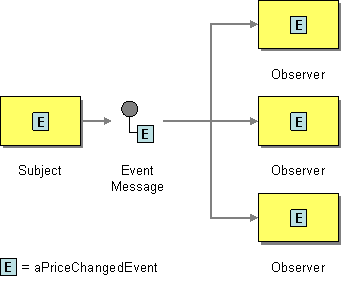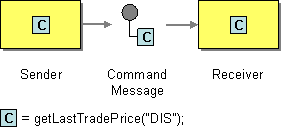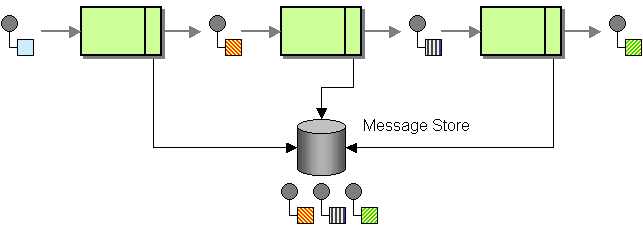Synapse is a library used to implement eventsourcing for Spring Boot applications.
In a distributed system, service must communicate with each other. In many cases, communication is implemented using request-response models like HTTP. Message passing is another option: tools like ActiveMQ, RabbitMQ, Kafka or Kinesis provide an infrastructure, to build such kind of message-passing architectures.
No matter, which solution you are using, you must decide which kind of message you want to send:
`de.otto.synapse.message.Message`
A Message is the basic unit of communication in a message-passing system. The most simple message will only carry
some payload like, for example, an ID, an object, a command or event. Messages have no special intent.
Having no special intent makes messages generic, but also less meaningful. That's why we can use two more concepts on top of messages.
In Synapse, messages are represented using de.otto.synapse.message.Message
See EIP: Message
There is currently no special representation in Synapse. Use `de.otto.synapse.message.Message` instead.
An event IS-A message which informs various listeners about something which has already happened.
Events are sent by message senders which doesn't know (and don't case) about the consumers of the event.
A typical example would be an online shop. Whenever an order is placed, the shop would publish an
OrderSubmittedEvent to inform other systems (e.g. the logistics system) about the new order. However, the shop
doesn’t care – or even know – about the consumers. If the logistics system isn’t interested in the events
anymore, it just unsubscribes from the list of consumers.
Because multiple consumers might be interested in receiving events, topics or message logs should be used to transmit events (one-to-many).
There is currently no special representation in Synapse. Use `de.otto.synapse.message.Message` instead.
A command IS-A message that carries the request to execute some action. Most of the time, commands will be transferred using point-to-point connections aka message queues.
In case of an online shop, one such example could be the BillCustomerCommand. After an order is placed, the online
sop sends this command to the billing system to trigger the invoice.
The difference between messages, events and commands lies in their intent. While messages have no special intent at all, events inform about something which has happened and is already completed (in the past). Commands trigger something which should happen (in the future).
`de.otto.synapse.message.Key`
Every Synapse Message has a Key that is especially used for partitioning and compaction purposes. A key is either
simple key (de.synapse.message.SimpleKey) containing something like an entity-id, or a compound key
(de.synapse.message.CompoundKey) consisting of a partition-key and a compaction-key (see section
Log Compaction for details about this).
final Key simpleKey = Key.of("urn:product:42");
final Key compoundKey = Key.of("urn:product:42", "urn:product:price:42");In most situations, the Key#partitionKey() of a message should be the primary key or entity-id of the entity, that
is addressed by the message. For example, a ProductUpdated event should use the product id of the updated product
as partition key for the message. This way, all the messages concerning a single product will be transmitted in order,
even if the transport channel is configured with several partitions.
The Key#compactionKey() could be something different. For example, product updates might need more than a single
kind of message: ProductDataUpdated, ProductPriceUpdated and ProductAvailabilityUpdated. All three messages should
be transferred using a single channel, and for all three messages, the partition key should be the product-id. In order
to keep the latest messages for every product, the compaction key could be something like <product-id>#DATA,
<product-id>#PRICE and <product-id>#AVAILABILITY. Now, all messages will be sent in order, also in partitioned
channel configurations, and message-log compaction will keep the latest messages for all three kinds of events.
Please not, however, that...
- ...different messaging systems might have restrictions regarding the length of message keys.
- ...you might need to later change message keys because of infrastructural changes or other changes in the message handling. Changes in the numbers of partitions, introduction of message compaction, etc. pp.
`de.otto.synapse.message.Header`
Synapse is supporting a number of default headers that are defined in de.synapse.message.DefaultHeaderAttr.
synapse_msg_id: Unique identifier of the message.synapse_msg_sender: The name of the message-sender.synapse_msg_arrival_ts: The header attribute containing the timestamp to which the message has arrived in Kinesis. Other channel implementations may use this attribute for similar timestamps, as long as the semantics of the property is the met.synapse_msg_sender_ts: The timestamp to which the message was sent.synapse_msg_receiver_ts: The timestamp to which the message was received by a MessageReceiverEndpoint.
Example: Reading headers
void foo(final Message msg) {
final String messageId = msg
.getHeader()
.getAsString(DefaultHeaderAttr.MSG_ID);
final Instant senderTs = msg
.getHeader()
.getAsInstant(DefaultHeaderAttr.MSG_SENDER_TS);
...
}See DefaultSenderHeadersInterceptor and DefaultReceiverHeadersInterceptor for details about how and when these headers will be available.
A StateRepository is a repository that is holding the current state of event-sourced entities. For example, a ProductStateRepository might contain Product entities, with some productId beeing the entityId used in the StateRepository as a key to look up products.
Synapse provides a number of default implementations for the StateRepository interface:
- ConcurrentMapStateRepository: A StateRepository that is using a configurable ConcurrentMap to store entities
- ChronicleMapStateRepository: A ConcurrentMapStateRepository using a ChronicleMap for large amounts of data stored outside off the heap.
The optional synapse-edison library contains an auto-configured UI for Edison microservices. For every StateRepository in the application context, a link to a page is registered in the /internal navigation. The UI renders a representation of all entities in the StateRepository using Jackson's ObjectMapper. Therefore, entities should be able to be transformed into a proper JSON representation, otherwise the UI will not be very helpful.
Registration of StateRepository UIs can be globally disabled by setting synapse.edison.state.ui.enabled = false.
Single repositories can be excluded, too: synapse.edison.state.ui.excluded = FirstStateRepository,SecondStateRepository
or, using Yaml configuration files,
synapse:
edison:
state:
ui:
enabled: true
excluded:
- FirstStateRepository
- SecondStateRepository Beside of the UI, Synapse-Edison also offers a REST-API to access the entities of the StateRepositories. The API
uses application/hal+json as media type and is accessible by default under /internal/staterepositories.
`de.otto.synapse.messagestore.MessageStore'
A MessageStore is a repository that is storing messages, while keeping the insertion-order of the messages.
The MessageStore interface supports streaming access to the stored messages. The implementation are expected to
support large amounts of messages, so returning collections instead of streams is not appropriate.
Messages can be originated in different channels. MessageStore.stream(channelName) provides access
to the messages for a single stream. Using MessageStore.getChannelNames(), the set of channel-names known by the
store can be accessed.
Synapse MessageStore also provides access to the latest ChannelPosition for every known channel name. The position
is derived from the (optional) message-header's ShardPosition, so it will only be usable for messages
originated in a MessageLog.
If the MessageStore is used as a store for message snapshots, the ChannelPosition can be used to determine the
starting position in a MessageLog.
In most cases, messages can be added to Message Stores. Only a few special-purpose implementation do not support adding messages to the store.
There are several implementations of the MessageStore interface available in Synapse:
de.otto.synapse.messagestore.OnHeapIndexingMessageStore: AMessageStorethat is implemented using aConcurrentLinkedDequewith support for message-indexing. Primarily used for testing purposes.de.otto.synapse.messagestore.OnHeapRingBufferMessageStore: AMessageStorethat is implemented using a GuavaEvictingQueue. Primarily used for testing purposes, or for smaller data-sets without any need for durability.de.otto.synapse.messagestore.OnHeapCompactingMessageStore: A compactingMessageStorethat is compacting messages by compaction-key when writing into the store. It's implementation is based on aConcurrentLinkedHashMapin order to preserve the insertion-order of messages.
For larger datasets, Redis is supported by the separate, add-on library synapse-redis. It can also be used to
access AWS ElastiCache.
de.otto.synapse.messagestore.redis.RedisRingBufferMessageStore: a Redis implementation of theMessageStoreinterface that can be configured with a maximum number of messages. The latest N messages will be stored, so the implementation is behaving like a fixed-sized ring buffer.de.otto.synapse.messagestore.redis.RedisIndexedMessageStore: another Redis implementation, that is using both maximum size + eviction to prevent theMessageStoreto increase in size without any bounds. This implementation is also offering a single index that is by default indexing the message's partition key. Using this index, it is possible to retrieve all messages for a given partition-key, which in most cases is equivalent to all the messages that where changing a single given entity.
The MessageStore interface is supporting basic indexing of stored entries. For example, you could add an Index for
the partitionKey of the messages, so you can later fetch the ordered list of messages for a given key:
@Configuration
public class TestConfiguration {
@Bean
public MessageStore messageStore(final RedisTemplate<String, String> redisTemplate) {
return new RedisIndexedMessageStore(
"test-store",
100 /* batch size */,
10000 /* max. number of entries */,
7*24*60*60*1000 /* evict entries after 7 days */,
Indexers.partitionKeyIndexer(),
redisTemplate);
}
}In order to retrieve all the messages for some partitionKey, MessageStore.stream(Index,String) can be used:
@Component
public class Foo {
private final MessageStore messageStore;
public Foo(final MessageStore messageStore) {
this.messageStore = messageStore;
}
public void printAllMessageFor(final String partitionKey) {
messageStore
.stream(Index.PARTITION_KEY, partitionKey)
.forEach(System.out::println);
}
}The current indexing capabilities are rather limited. While it is already supported to add several indexes, it is only
possible to stream the messages for a single index. However, you can stream the messages for an index, and use
Stream.filter to further reduce the stream using filter values. To do this, MessageStoreEntry.getFilterValues()
contains the filter values for all calculated indexes.
To create multiple indexes, Indexers.compositeIndexer() can be used to create a composite from two or more Indexer
implementations:
final Indexer indexer = Indexers.composite(
Indexers.partitionKeyIndexer(),
Indexers.originIndexer("Snapshot"),
Indexers.serviceInstanceIndexer("my-service@localhost:8080")
);If the RedisIndexedMessageStore (or some other implementation supporting indexes) is created with this indexer, for every message added to the store, all three indexes will be updated. Now we can retrieve all messages that originated in the snapshot that where added to the store by my-service:
messageStore
.stream(Index.ORIGIN, "Snapshot")
.filter(entry -> entry
.getFilterValues()
.getOrDefault(Index.SERVICE_INSTANCE, "")
.startsWith("my-service"))
.forEach(System.out::println);One of the promises of eventsourcing architectures is the possibility to not only see the current state of some
entity, but also to track and analyze all the single changes that lead to the current state. In Synapse, the
Journal takes responsibility for providing exactly this functionality.
A Journal contains all the messages that where leading to the current state of a single event-sourced entity
stored in a StateRepository or in some other kind of storage.
Messages can come from different channels. The Journal will keep track not only of the messages for a single
entity, but also from the originating channel for every message.
The messages of a Journal will be stored in a MessageStore. The store must have a
journal-key index (see Index.JOURNAL_KEY), so the Journal is able to return the Stream
of messages (more precisely MessageStoreEntry) for every entity stored in the StateRepository
when calling Journal.getJournalFor(String).
In order to identify the messages for an entity, Journal.journalKeyOf(String) must return the key of
the associated messages for a given entityId, which is the key of the stored entities: the key that
would be used, for example, to get the entity from the StateRepository.
A number of default implementations of the Journal interface can be created using the helper class
de.otto.synapse.journal.Journals.
The following example is showing how to configure a StateRepository that has a Journal for two
different channels:
@Configuration
@EnableEventSource(
name = "priceUpdateSource",
channelName = "price-update-channel")
@EnableEventSource(
name = "availabilityUpdateSource",
channelName = "availability-update-channel")
public class ExampleConfiguration {
private static final Logger LOG = getLogger(ExampleConfiguration.class);
@Bean
public StateRepository<PricesAndAvailabilities> stateRepository() {
return new ConcurrentMapStateRepository<>("Prices with Availabilities");
}
@Bean
public Journal journal(final StateRepository<PricesAndAvailabilities> stateRepository) {
return multiChannelJournal(
bananaProductStateRepository,
"price-update-channel",
"availability-update-channel");
}
}The Journal needs to know about the channels that are the source for entities stored in the StateRepository,
otherwise it would not know about the connection between the messages from the channels, and the entities stored
in the repository.
Synapse will take care of auto-configuring the JournalingInterceptor instances required to add incoming messages
to the journal(s). Multiple journals for different (or same) channels are supported, so even in more complex situations,
journaling can be used to track the processing of messages in Synapse services.


